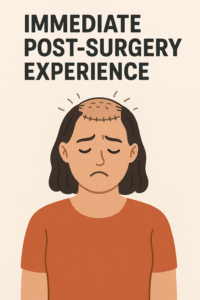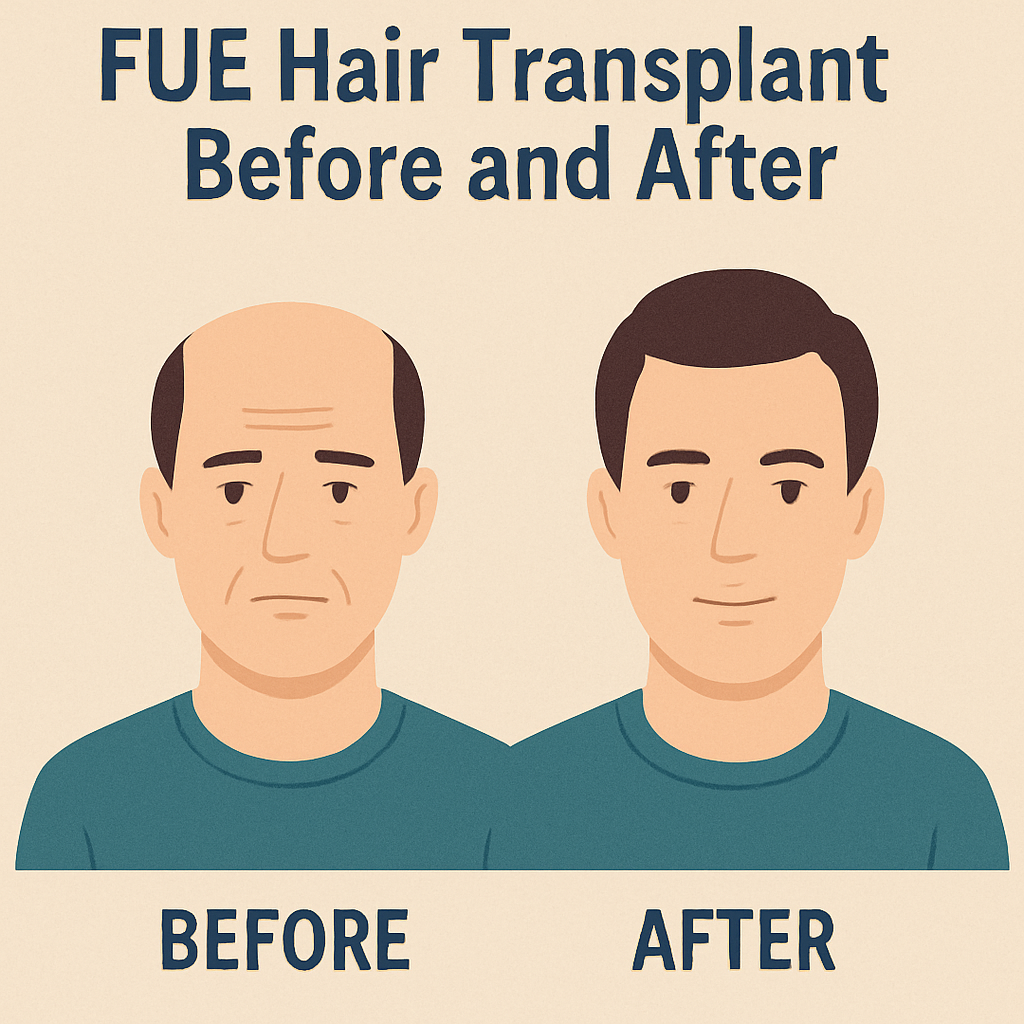Hair loss can quietly chip away at your confidence—until one day, you realize your hairline just isn’t what it used to be. That’s where FUE (Follicular Unit Extraction) steps in. But before you dive in, you want to know: what does the FUE hair transplant before and after journey truly look like?
This post reveals realistic expectations, a full recovery timeline, and everything in between. Whether you’re researching for yourself or someone else, this is your ultimate guide to FUE hair transplant transformations.
What Is FUE Hair Transplant?
FUE (Follicular Unit Extraction) is a modern hair restoration technique that involves harvesting individual hair follicles from a donor area and transplanting them into areas experiencing thinning or baldness. Unlike older methods, FUE leaves no linear scars and allows for faster recovery and more natural results.
How Does FUE Work?
FUE works by:
Extracting individual hair follicles (usually from the back of the head).
Creating tiny incisions in the bald or thinning area.
Implanting each follicle strategically for optimal density and natural direction.
This precise approach ensures that the results are seamless and undetectable, even to the trained eye.
FUE vs. FUT: What’s the Difference?
| Feature | FUE | FUT (Strip Surgery) |
| Scarring | Tiny dot scars | Linear scar |
| Recovery time | 7–10 days | 10–14 days |
| Graft quality | Excellent (if done well) | Higher yield per session |
| Haircut options | Can wear hair short | Limited due to a visible scar |
| Technique | Individual follicle extraction | Strip of skin removed and dissected |
Who Is an Ideal Candidate for FUE?
You’re a great FUE candidate if you:
Have mild to moderate hair loss (Norwood scale 2–5)
Have a healthy, dense donor area
Are seeking a natural look without visible scarring
Want a quicker recovery
We are committed to realistic expectations
Preparing for the Procedure
Before surgery, your clinic may ask you to:
Stop blood thinners or anti-inflammatory drugs
Avoid alcohol and smoking (1–2 weeks prior)
Get blood tests to check for suitability
Wash your hair thoroughly with an antiseptic shampoo
Pro tip: Start taking multivitamins and following a healthy diet to improve scalp healing post-op.
Step-by-Step FUE Procedure
Here’s how your FUE surgery day typically goes:
Step 1: Local Anesthesia
Your scalp is numbed using local anesthesia to ensure you feel no pain.
Step 2: Follicle Extraction
Using a micro punch tool (0.6–1mm), the surgeon extracts hair follicles one by one from the donor area.
Step 3: Graft Sorting
Technicians sort and clean grafts based on follicle count (1–4 hairs per unit).
Step 4: Recipient Site Creation
Tiny incisions are made in the recipient area with specialized tools, matching your natural hair growth angle.
Step 5: Graft Implantation
Each follicle is carefully placed into the recipient area, ensuring symmetry, density, and a natural look.
The whole process may take 4 to 8 hours, depending on the number of grafts.
Immediate Post-Surgery Experience
After the procedure:
Mild swelling and redness in donor/recipient areas
Tiny scabs form around grafts
You’ll be given a post-op kit: saline spray, antibiotics, pain relievers, and care instructions

Day-by-Day & Month-by-Month Recovery Timeline
📅 Day 1–3
Minor bleeding and swelling may occur
Use a saline spray every 30–60 minutes
Avoid touching your scalp
📅 Day 4–7
Scabs form, and itching begins (do NOT scratch)
Grafts are anchored to the scalp
📅 Week 2
Most scabs fall off naturally
Transplanted hair starts shedding (shock loss)—normal!
📅 Month 1–2
You may look similar to pre-op
Hair is in the resting (telogen) phase
📅 Month 3–4
“Baby hairs” emerge
Soft, fuzzy regrowth appears
📅 Month 5–6
Density improves, hairline takes shape
Hair grows faster, thicker
📅 Month 7–9
Up to 70% visible result
Patients often return for review appointments
📅 Month 10–12
Full results visible
Hairs are mature, thick, and dense
What to Expect: Before and After Results
You won’t see instant full hair. But over time, the difference is dramatic.
🔍 Before FUE:
Visible thinning
Bald patches or receding hairline
Reduced confidence, limited hairstyle options
📈 After FUE:
Fuller, denser hairline
No visible scars
Permanent results
Improved self-esteem
Hair Growth Cycle After Transplant
Hair follicles cycle through 3 phases:
Anagen (growth phase): Begins ~3 months after FUE
Catagen (transition phase)
Telogen (resting/shedding phase): Happens immediately post-surgery
Pain, Side Effects & Scarring
FUE is largely painless during surgery, but here’s what to expect:
Mild soreness for 2–4 days
Numbness in the donor area (temporary)
Red dots or tiny scars (fade with time)
Rare risks: folliculitis, infection, or graft failure (<5%)
Real-Life Patient Transformations
🔹 Patient A (Male, 34)
Grafts: 2500
Problem: Receding temples, thinning crown
Result: Fuller front and crown, visible by Month 6, full by Month 11
🔹 Patient B (Female, 41)
Grafts: 1500
Problem: Widened part line, post-menopausal thinning
Result: Natural density restored, dramatic change in confidence

Pros and Cons of FUE
✅ Pros:
Minimally invasive
No stitches or linear scar
Fast healing
High success rate
Long-lasting results
❌ Cons:
Takes longer than FUT
Requires an experienced surgeon
Can be expensive
Might need 2nd session for large areas
How Much Does FUE Cost?
FUE is priced per graft and varies by country and surgeon skill.
| Country | Cost per Graft | Average Total Cost |
| USA | $4–10 | $6,000–$15,000 |
| UK | £3–6 | £4,000–£9,000 |
| Turkey | $0.75–2 | $1,800–$4,500 |
| India | ₹30–₹100 | ₹70,000–₹2,50,000 |
Tip: Don’t just look at price—check clinic hygiene, credentials, and patient reviews.
Tips for Maximizing Your FUE Results
Avoid smoking and alcohol for 2 weeks post-op
Use minoxidil or finasteride (if advised)
Eat protein-rich, anti-inflammatory foods
Sleep on your back with a neck pillow
Don’t touch or scratch your scalp!
Stick to your follow-up schedule
Conclusion
FUE hair transplants offer a real solution for long-term hair restoration with natural results and minimal downtime. The “before and after” can be astounding—but patience is key. Follow instructions, trust the process, and within 12 months, you’ll likely have a brand-new head of hair to show off.
FAQs
❓ How long does a FUE hair transplant last?
Forever! Transplanted hair usually doesn’t fall out, since it’s resistant to DHT (the hormone behind baldness).
❓ Will I need more than one session?
Some patients with extensive baldness may need a second session after 12–18 months for the desired density.
❓ When can I go back to work?
Usually within 2–5 days, depending on job type.
❓ Can I wear a hat after surgery?
Yes, after 5–7 days (only soft, loose caps). Avoid tight headwear until full healing.
❓ Is FUE safe?
Absolutely—when done by certified, experienced professionals using sterile equipment.

